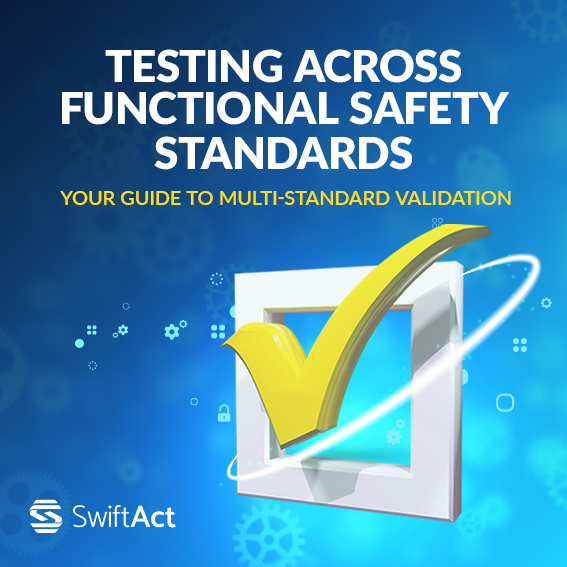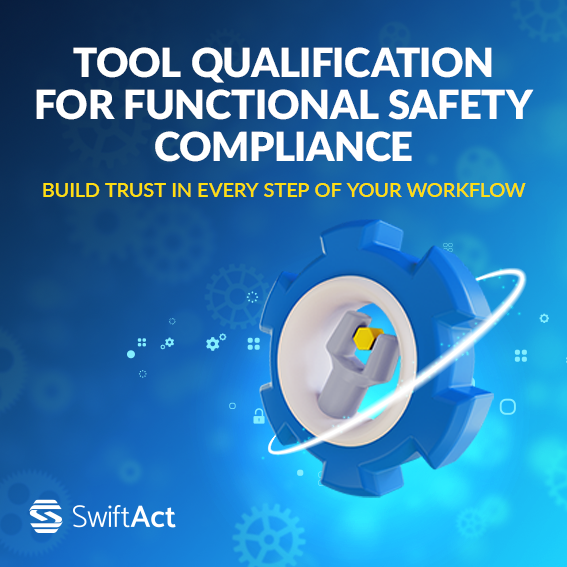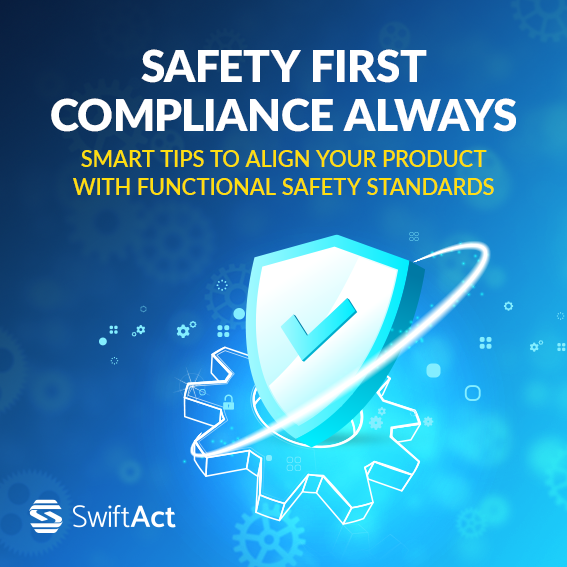Ever had your wireless earbuds momentarily desync left and right channels, your washing machine stalls with a tub full of soapy water, or the coffee maker’s touch panel freezes—you power-cycle it and move on?
Annoying, but usually harmless. Now picture the same glitch in a car’s power-steering module, a home gas-boiler controller, or a hospital ventilator skips a breath-timing trigger. A simple hiccup can instantly swing from nuisance to danger.
That mental jump is what drives functional safety—the discipline that asks, “What if this everyday function fails at the worst moment, and how do we guarantee people stay safe?” It builds guard-rails around critical functions, so the product either keeps operating safely or moves itself into a harmless state when things go wrong.
Why we bother
Cars, factories, and household gadgets are now “systems of systems.” One flipped bit, one missed sensor frame, and a steering command can vanish. A brake might pull unevenly, or a medical pump could double its dose. Any single slip can injure or kill. Functional safety provides the structured rules (ISO 26262, IEC 61508, etc.) and the risk-based mindset to catch faults early, contain them, and keep overall danger at a level society can accept. It isn’t red tape; it’s the price we pay to trust complex tech with human lives.
Testing is where the theory of functional safety finally meets the sweaty reality of code. Sensors and silicon Design reviews, and FMEAs can predict what might go wrong, but only disciplined multi-level testing tells us what does go wrong, how often, and under which corner-case conditions. Safety standards are unambiguous on this point: no amount of clever architecture or certified components excuses weak verification.
Why We Invest in Rigorous Testing
The V-model tells the story: requirements flow down the left-hand leg until they crystallise into source code; verification climbs back up the right-hand leg to prove every promise was honoured.
Design reviews and FMEAs anticipate faults, but only disciplined, multi-layer testing produces hard evidence that the real code, on real hardware, consistently behaves under worst-case conditions.
| Verification lane | Question it answers | Activities | When it happens |
| 1. Code quality gate | Does the code meet our engineering quality rules? | Static analysis, MISRA / CERT compliance, data-flow checks | As soon as code compiles and again before release |
| 2. Intended-behaviour proof | Does the code do what it should? | Requirements-based tests, performance / timing checks, resource-usage tests | Unit ➜ integration ➜ system levels |
| 3. Unintended-behaviour defence | Does the code not do what it should not do? | Robustness, boundary, equivalence-partitioning, fault-injection | Mostly unit & integration levels |
| 4. Test sufficiency evidence | Have we tested enough? | Structural coverage (statement, branch, MC/DC, etc.) + requirements traceability | Continuously, reported per build |
Zoom Levels and Their Payoffs
| Test level | Scope | Why it matters in FuSa |
| Unit | Single source file / class / function | Catches logic slips before they cascade; provides low-cost MC/DC coverage |
| Integration | Cluster of units exercising real interfaces | Reveals timing/resource interactions that unit tests can’t see |
| System | Deployed binary on target HW/SW stack | Confirms end-to-end safety mechanisms (watchdogs, FTTI, degradation modes) |
Testing Methods Mandated by Major Standards
Safety standards require, and recommends test methods to cover different artefacts, and areas across the software, below is an augmented cross-standard matrix.
It’s crucial to understand that this is simplification. The actual requirement for any given method is almost always dependent on the safety integrity level (e.g., ASIL in automotive, DAL in avionics, SIL in industrial/rail, or Class in medical) of the software being developed.
| Test Method | ISO 26262-6 (Road Vehicles) | DO-178C (Avionics) | IEC 62304 (Medical) | IEC 61508-3 (Generic) | EN 50128 (Rail) |
| Static Analysis | ✓ | ✓ | ✓ | ✓ | ✓ |
| Requirement-Based Testing | ✓ | ✓ | ✓ | ✓ | ✓ |
| Data / Control Flow Testing | ✓ | ✓ | ✓ | ✓ | ✓ |
| Equivalence Partitioning (EP) | ✓ | ✓ | ✓ | ✓ | |
| Boundary Value Analysis (BVA) | ✓ | ✓ | ✓ | ✓ | ✓ |
| State Transition Testing | ✓ | ✓ | |||
| Resource Usage Analysis (Memory, Stack, etc.) | ✓ | ✓ | ✓ | ✓ | ✓ |
| Timing Analysis (Execution Time) | ✓ | ✓ | ✓ | ✓ | ✓ |
| Error Guessing | ✓ | ✓ | ✓ | ✓ | |
| Fault Injection | ✓ | ✓ | ✓ | ✓ | ✓ |
| Structural Coverage (Code Coverage) | ✓ | ✓ | ✓ | ✓ | ✓ |
These five standards all land on the same truth: test evidence is not optional; it is the admission ticket to certification. Each framework lists the fundamentals – static analysis, requirement-based tests, data-flow checks, structural coverage and so on, but it also scales the demand as the safety-integrity level climbs. At the top tier you’re expected to deliver deep dynamic testing (fault-injection, overload, race conditions), granular structural coverage (MC/DC), timing proofs, and tool-qualification evidence, layered on top of the “always required” hygiene gates (reviews, static analysis, basic functional tests).
The only practical way to keep pace is an automated test environment that generates, schedules and executes suites around the clock, feeding results straight into traceability dashboards. Automation slashes human error, keeps the regression queue short and, crucially, protects launch dates from last-minute surprises. In short, higher safety means heavier proof.
Automation—The Only Economical Path to 100 % Evidence
Manual testing cannot keep pace with:
- Regression depth. Each code change ripples through thousands of safety requirements.
- Coverage granularity. MC/DC explodes test-case counts unless tools synthesise input vectors.
- Traceability payload. Modern certificates expect clickable links from requirement → test-case → code → coverage report.
At Swift Act, we accelerate the SDLC in parallel with safety certification by automating our quality gates and executing multi‑layer test campaigns through deterministic test harnesses as well as Software‑in‑the‑Loop (SIL) and Hardware‑in‑the‑Loop (HIL) rigs. This integrated automation backbone compresses release cycles while keeping each artefact audit‑ready.
Conclusion
Functional safety is not paperwork; it is data‑driven confidence. Static analysis proves code is tidy; requirements & robustness tests prove behavior; structural coverage proves we looked everywhere. Different industries phrase the rules differently, but the universal spine is shared. Adopt a disciplined, automated testing pipeline that walks the right‑hand leg of the V‑model every day, and you will satisfy auditors, protect end‑users, and free engineers to innovate

1 | Everyday Glitches vs. Catastrophic Failures
Ever had your smart thermostat overshoot the set-point, your robot vacuum freeze mid-room, or your streaming box reboot during a match? Mild inconvenience—power-cycle and move on.
Now transpose that glitch to a power-steering ECU, a gas-boiler controller, or an ICU ventilator. One hiccup leaps from nuisance to danger.
That mental jump is the essence of functional safety—the discipline that keeps critical functions either operating safely or steering into a harmless state when all else fails.
2 | Why We Invest in Rigorous Testing
Connected products are now systems-of-systems; one flipped bit or delayed interrupt can injure or kill. International standards—ISO 26262, IEC 61508, IEC 62304, DO-178C, EN 50128—codify the risk-based rules that society accepts as the price of trust.
Design reviews and FMEAs anticipate faults, but only disciplined, multi-layer testing produces hard evidence that the real code, on real hardware, consistently behaves under worst-case conditions.
3 | Where Verification Fits—The V-Model at a Glance
| Verification Gate | Question Answered | Typical Activities | Trigger Point |
| Code-Quality Gate | Does the code obey our engineering rules? | Static analysis, MISRA/CERT checks, data-flow reviews | Each build & pre-release |
| Intended-Behaviour Proof | Does the code do what it should? | Requirements-based & timing tests, resource-usage checks | Unit → Integration → System |
| Unintended-Behaviour Defence | Does the code not do what it mustn’t? | Boundary analysis, fault-injection, robustness suites | Mostly Unit & Integration |
| Test-Sufficiency Evidence | Have we tested enough? | Structural coverage (statement → branch → MC/DC) + traceability | Continuous, build report |
Coverage metric is integrity-level specific—e.g., ASIL D / DO-178C Level A demand MC/DC, while IEC 62304 Class B accepts branch coverage.
4 | Zoom Levels and Their Payoffs
| Test Level | Scope | FuSa Rationale | Real-World Tool Hooks |
| Unit | Single compilation unit / class / function | Catches logic slips early; low-cost path to 100 % MC/DC | GoogleTest + Bullseye, CppUMock, Tessent |
| Integration | Cluster of units exercising real interfaces | Exposes timing and resource interactions invisible at unit level | Vector CANoe, ETAS LABCAR, custom API shims |
| System | Deployed binary on target HW/SW stack | Validates watchdogs, FTTI, degradation modes end-to-end | dSPACE SCALEXIO HIL, NI-PXI fault-injection, Lauterbach |
5 | Cross-Standard Verification Matrix (with Clauses)
| # | Test / Verification Method | ISO 26262-6 (ASIL D) | DO-178C (Lvl A) | IEC 62304 (Class C) | IEC 61508-3 (SIL 3) | EN 50128 (SIL 4) | Reference* |
| 1 | Static code analysis | ✓ | ✓ | ✓ | ✓ | ✓ | 26262-6 §9.4.5(c); DO-178C Tbl A-5 Obj 5; 62304 §5.5.3; 61508-3 Tbl A.12; 50128 Tbl A.4 |
| 2 | Peer code review | ◆ | ✓ | ✓ | ✓ | ✓ | 26262-6 §9.4.5(d); DO-178C §6.3.2; 62304 §5.5.4; 61508-3 Tbl A.13; 50128 §6.3.4 |
| 3 | Requirements-based functional tests | ✓ | ✓ | ✓ | ✓ | ✓ | 26262-6 §10.4.6; DO-178C Tbl A-7 Obj 2; 62304 §5.6; 61508-3 §7.4.4; 50128 §4.2 |
| 4 | Boundary-value analysis | ✓ | ✓ | ◆ | ✓ | ✓ | See above clauses + DO-330 Tbl B-4 for tool qual. |
| 5 | Fault-injection / error seeding | ✓ | ◆ | ◆ | ✓ | ✓ | 26262-6 §10.4.6(g); DO-178C §6.4.4.1d; 62304 Amd1 Annex C; 61508-3 Tbl A.16; 50128 §6.8 |
| 6 | Timing / WCET tests | ✓ | ✓ | ◆ | ✓ | ✓ | 26262-6 §11.4.5; DO-178C §6.4.4.2; 62304 §5.8; 61508-3 §7.4.12; 50128 §6.7 |
| 7 | Structural coverage | ✓ | ✓ | ✓ | ✓ | ✓ | 26262-6 §9.4.5(f); DO-178C Tbl A-7 Obj 6; 62304 §5.7.5; 61508-3 §7.4.10; 50128 §6.9 |
Legend: ✓ = Explicitly required (highest integrity class); ◆ = Highly recommended; — = Not explicitly addressed
*Clause citations use latest amendments as of June 2025.
Key Observations
- Static analysis + requirements-centred testing are non-negotiable everywhere.
- Divergence shows up in robustness and resource/timing tests—mirroring domain-specific hazards.
- “Coverage complete” means complete for the mandated metric—100 % statement beats 90 % MC/DC.
6 | Automation—Scaling Evidence to 100 %
Manual testing collapses under:
| Challenge | Why Automation Wins |
| Regression depth | Impact analysis scripts select only the changed-function test set ⇒ minutes, not days. |
| MC/DC explosion | Vector or Rapita tools auto-synthesise input vectors; human generation is infeasible. |
| Traceability payload | ALM (Application Lifecycle Management) suites—e.g., Polarion, Codebeamer—consume JSON or REST feeds from test rigs, building real-time audit trails. |
Swift Act’s Reference Loop
- Harness generator emits host-side and target-side stubs per commit.
- Dual execution on GCC/Clang and qualifier compiler (e.g., Green Hills) to catch toolchain quirks.
- Coverage merger uploads .xccovreport & .gcov into ALM; requirement ⇄ test ⇄ code links materialise instantly.
- CI gatekeeper in GitHub Actions / Gerrit blocks merge on any failed lane or coverage dip.
Result: confirmed in an ASIL C powertrain project—release cadence shrank from 12 → 6 weeks while certification artefact count doubled.
Alternative terminology: ALM is also labelled SDLC management suite or PLM test-collaboration module in some organisations.
7 | Common Pitfalls & How to Dodge Them
| Pitfall | Mitigation |
| Late-stage coverage chase | Enforce coverage thresholds from sprint 1; break the build early. |
| Non-deterministic tests | Isolate hardware timers, mock randomness, and pin OS scheduling via affinity. |
| Unqualified tools | Apply ISO 26262-8 tool-classification; qualify per DO-330 if re-used for avionics. |
8 | Conclusion & Next Step
Functional safety is not paperwork; it is data-driven confidence.
- Static analysis proves code hygiene.
- Requirements & robustness tests prove behaviour.
- Structural coverage proves we inspected every path.
Adopt a disciplined, automated verification pipeline that walks the right-hand leg of the V-model every day and you will:
✔ satisfy auditors ✔ protect end-users ✔ free engineers to innovate
Ready to cut verification time in half? → Book a 30-minute scoping workshop with Swift Act’s FuSa automation team.



